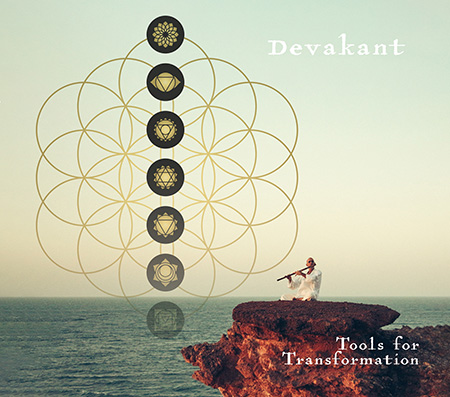‘Tools for Transformation’

Nirbija reviews Devakant’s latest album: A fresh musical experience for breathing into the chakras and other techniques.
Tools for Transformation
by Devakant
Pao Pamaki add. vocals on Chakra Breathing
Mixing/mastering and graphic design by RajRishi
1. Chakra Breathing 19:03 (also 3x + silence = 70:00*)
2. Latihan 15:20
3. Mahamudra 15:26
4. Aloop 19:06
Download and instructions: devakant.bandcamp.com
* longer versions available from www.devakant.com
Devakant’s captivating compositions and especially his masterfully-played flutes have always been associated with a meditative space. Last year he composed this new album with four meditation techniques. I can recommend checking out this inspiring album.
Chakra Breathing (track 1)
In our etheric body there are points positioned like a ladder reaching from the base of the spine to the top of the head. They are called chakras. Since ancient times mystics have considered them as doorways to the inner world. Devakant writes in the instructions:
Each chakra has a particular function for the whole body, relating to issues such as survival, reproduction, willful action (power), sharing love, creativity, communication, higher mental capacities such as clairvoyance and telepathy, and connection with the Universal Source. Remain with each chakra, letting the breath activate it, and release tensions there. The story will unfold on its own.
Devakant uses his skills as a meditator, composer and multi-instrumentalist to paint a colorful acoustic scenery for each chakra. It’s like entering an inner landscape; the rhythmic music for the first chakra can be associated with sounds of the jungle. Breathing into the second chakra, I float into a jazzy lounge with brass and percussions. Each stage creates a different, even playful, atmosphere inviting my body to move and pull in fresh air. Arriving at the third chakra the music reminds me of the opening trailer for a Samurai movie, where his flute magically touches the scene. The fighters shed their armor and rejoice. The fourth chakra opens the door to the heart space, Pao Pamaki’s voice an invocation of love to soar high. I feel grateful for each breath. Most probably you will find your own pictures arising for each new inner door.
Joyfully with my arms swaying, I breathe intensely on this rejuvenating musical journey. I feel invigorated and lifted by these inspiring and playful tunes. They help me discover how each chakra leads to a different inner space and relax into each one of them. Chakras are often pictured as moving wheels, which indicates that they are constantly changing. So, each time you do this meditation the experience can be totally different. You will discover much on this inner voyage!
Osho gives a guideline for this type of technique: Remember this: whenever you do this experiment, don’t leave it in the middle. You have to complete it. Take care that no one disturbs you. (Vigyan Bhairav Tantra, Vol 2, Ch 7) Which means that it is good to go each time through all seven chakras. Sufis are said to repeat their rituals three times. So one might breathe through all the seven chakras three times and then rest for 10 minutes (a 70-minute file is also available).
Winds of change?
Chakra Breathing was introduced as meditation – with its music – by the Osho Mystery School in Pune in the late 80’s. Kaveesha, Waduda and Wadud and others were instrumental in its creation, receiving feed-back from Osho.
Osho suggested for other meditations like Dynamic and Kundalini not to change the music, as with time it becomes ingrained in us and thus helps us enter that particular meditative state more easily. So the question came to my editor, why create new tracks for Chakra Breathing? Enthusiastic as I was about Devakant’s album I was very eager to write a review without even having thought about that. Was I deluded by ideas like diversity and creativity? I loved his new, playful approach and musical innovation in general. Or is the chapter of meditation music, once recorded, closed for a good reasons?
Belonging to the sannyas generation that was frequently in India, I have to admit that my personal preference in perceiving meditation music has been influenced by these visits. Also having experienced meditation around Osho I am thrilled by hearing emptiness, and having a taste of the Source in music. But the winds of change bring a new generation of meditators with a different music taste for going inwards. When asked about this subject Devakant wrote:
Yes, there is something to be said for continuity and letting a certain music sink deeper for years without change. But I never felt that way about Chakra Breathing. I was called by an inner urge to do it in a different way, as I have used that meditation in my groups for many years, and found that the music I was doing live worked better than the recording. So I decided to have a go at a studio version, as many participants were always asking me for a recording of the music.
The proof is in the pudding, as they say. If it helps someone to delight in meditation and actually move inward, with enthusiasm, then great! And if not, everybody is free to choose. Millions of meditators have millions of paths. Along with that, I don’t think chapters are ever closed.
Devakant has been with Osho for 43 years, lived 12 of those with him, and was under his direct personal guidance about how to create meditative music. He is also a live performing artist, now mostly in Chile and no doubt has experienced the changes in musical tastes.
In a recent video interview in the video, Samasati. Belleza Humana, he stated:
People can hear a sound and it can take them into a state where they remember something about themselves – that they have forgotten, remember something about their vastness, ancient collective memories. If I can just scratch that a little bit and wipe the dust off the mirror and they look in – that is great, that is what I hope for.
To meditate with Devakant’s version worked very well for me and for a friend, a seasoned meditation leader whom I had asked to try it out. She wrote that it was so stimulating for her body that after three days she got sore muscles and had to rest, but then decided to carry on. Interestingly, the depth of Devakant’s voice guiding the meditator from chakra to chakra triggered laughter in her. Not about him or his voice – but there was just laughter.
Aloop (track 4)
Aloop is my favorite. It is a variation of Chakra Breathing. This 20-minute composition is inspired by the rich scales of Eastern sounds and its typical instruments. It has a flavor of emptiness and is without vocals. A constant rhythm flows like a heartbeat through the process of imagining the in-breath going into one chakra and the out-breath through a higher chakra, creating a loop between these two energy centers. And then up the ladder we go. I was surprised to find that this technique relaxed me the most when doing it lying down and breathing slowly.
I tried it before going to sleep and after waking up in the morning. It was relaxing and refreshing. Once I noticed a peristaltic movement as if an energetic block were released. I would repeat this meditation also three times and then add a ten-minute silent phase at the end.
Latihan (track 2)
Latihan is based on a technique introduced by the Indonesian mystic Bapak Subuh. Gurdjieff’s disciple, John Bennett, practiced it for a while. Osho commented on it stating that it is relaxing, but misses the element of witnessing. He used this method in a-10 minute sequence in the Gourishankar Meditation.
In Latihan we aim to give up all control of the body and mind so that a new life force can take over. It can result in liberating movements that are as if one is in the hands of unknown energies. I found Devakant’s composition for a 15-minute Latihan inspiring with it dense musical atmosphere. And just to relax and go inside is such a gift in these times.
Mahamudra (track 4) – Prayer Meditation
With Mahamudra, Devakant revives the ancient method of prostrating oneself onto the earth in a prayerful mood. It is a traditional way to take refuge in the divine and Mother Earth. This composition is inviting, childlike and innocent. People who are new on the path will easily feel invited to try it out. I found the vocals a bit repetitive, especially if I imagine hearing them again and again. In an earlier, also recorded music version of the Prayer Meditation (but now no longer available), Osho instructed us to touch the earth at least seven times – one movement for each chakra.
More new music for meditation
While writing this, Devakant announced that a new album is in the making and will probably be called ‘Elemental Healing’. So stay tuned.
Related articles
- Devakant – A video interview of Devakant from the Czech ‘Voices of Meltingpot’ series. Here he speaks about music (“the queen of the arts”), his first spiritual experience, how he discovered Osho, how Osho worked on him, and about creativity and discipline.
- ‘In the Eye of the Hurricane’ – Veena reviews Devakant’s memoir
Nirbija is a writer, facilitator of Osho’s meditations, and enjoys life in the countryside.
- Log in to post comments
- 13 views
